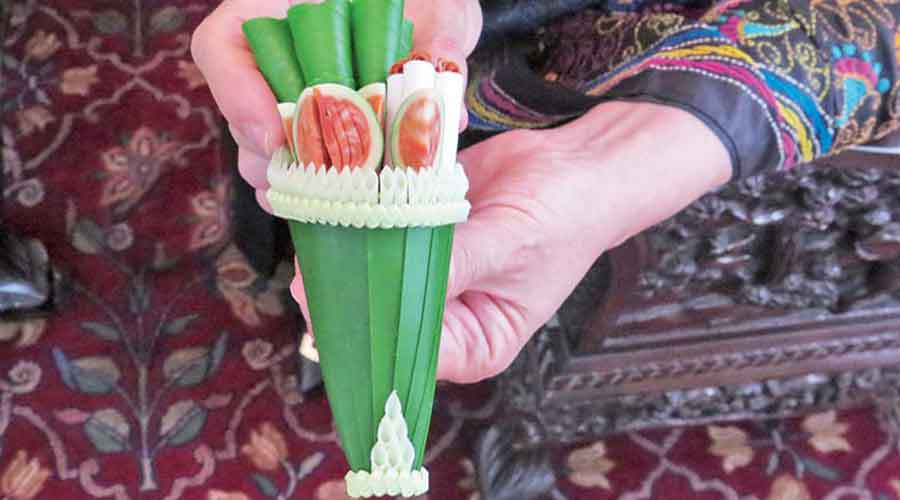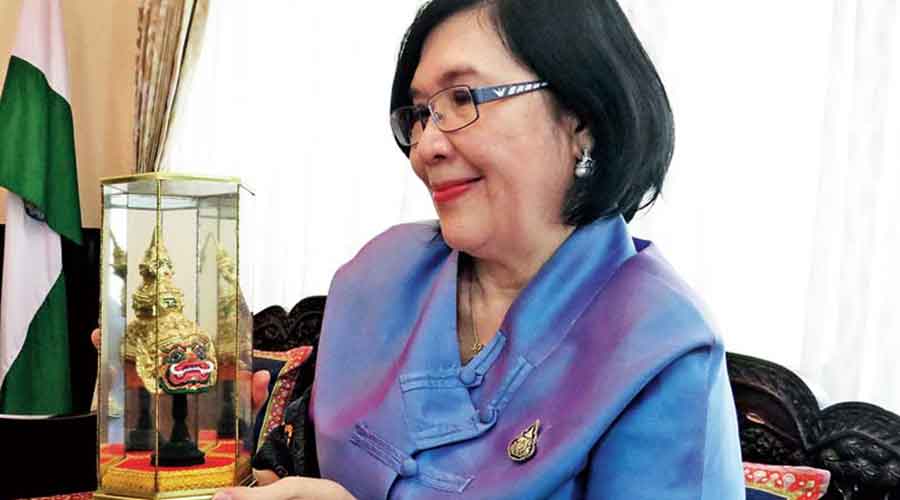Earlier this month, the ever-smiling and elegant Sweeya Santipitaks called time on not just her Calcutta posting but also her three-decade career as a diplomat. The consul general of the Royal Thai Consulate, whose father had served in the same position 38 years ago, shares her parting thoughts with t2 at her Alipore residence.
You had a chance to see Calcutta for a year and half before lockdown.
Yes. I came in the winter of 2018 and there were a lot of invitations. I enjoyed the cultural programmes. People of Calcutta are so friendly.
How did life change for you afterwards?
Like everyone else, I had to learn how to spend more time at home without getting anxious. I could adapt myself. It became easier after one month. We held several events online, including the Thai Festival 2021.
Did you pick up any hobbies during the lockdown months?
I learnt hydroponics. That’s the art of gardening without using soil, only in water. It is popular in India as well but the liquid fertiliser is a bit costly. I had some seeds from Thailand and I grew them, taking tips from YouTube and asking the suppliers. But they did not grow as fast as the advertisement claimed they would.

This is what I plan to learn to make after retirement. This is the Thai version of paan in banana leaf made of artificial clay. It is easy to mould. We call it Thai clay art. It is a nice hobby. Those who are good at it also sell it. There are web pages where people learn from each other and also post pictures of their creations Sourced by The Telegraph
Was it a success?
Well... (pauses) Some survived! The soil here is sticky, which is different from that in Thailand. Sticky soil is good for the big trees, though. I also tried to meditate though not too successfully. I would fall asleep. (laughs)
Now that restaurants have opened up again, how authentic in your view is the Thai cuisine served in Calcutta?
In any place, one has to adjust the food to suit the local preference. May be it has lost the authenticity a little. But if you ask for authentic food, the chef at the restaurant will surely serve it. What I found is sometimes Thai food in Calcutta is a bit more salty than it should be. In Thai cooking, we use fish salt, which is a diluted version of salt and therefore does not have the sharp saltiness. It also elevates the taste. Vegetarians, who cannot use fish salt, can use light soy sauce as an equivalent.
Our ministry of commerce gives out the Thai Select certificate to authentic Thai eateries abroad. Baan Thai at Oberoi Grand received the first one in Calcutta this July, which we handed over, in collaboration with the Thai Trade Centre in Delhi.
Because of the price, Thai cuisine is not easy to access for ordinary people. You don’t have Thai fast food in malls. I’d like to see a Thai food franchise in every Calcutta mall at an affordable price.

Consul general of Thailand Sweeya Santipitaks at her residence in a sari Sourced by The Telegraph
Have you started accepting tourists in Thailand?
Thailand has gradually reopened for foreign visitors, including Indians, depending on risk factor as safety and health of both local Thais and foreign visitors are our priority. From September 21, we have resumed the issuance of all type of visa and Certificate of Entry (COE) for permitted non-Thai nationals travelling from India to Thailand, except for medical treatment. In addition, Indians who are fully vaccinated (with Covishield) can now travel to Thailand through Phuket Sandbox Programme and SamuiPlus Program.
But there are two obstacles for the tourist — a ban on scheduled international commercial flights in Thailand and India has remained in force since the onset of the pandemic in March 2020. Travelling to Thailand from India has been limited to the repatriation flights, organised occasionally by the Thai Consulates in Chennai and Calcutta, and Air India’s Vande Bharat flights to from Delhi to Bangkok. Travelling with semi-commercial airlines via the Central Asia countries is still possible but the airfare is high. The second obstacle is Thailand still imposes a two-week quarantine on anyone coming in. Even I will have to follow the rule when I return.
How was your experience of repatriating Thai citizens?
We repatriated 938 Thai nationals through last year. Most of our flights were from Gaya as that is where the Thai Buddhist monks and nuns were. Our most challenging repatriation flight was the evacuation of Thai nationals on the Calcutta-Bangkok route during May 20-22 last year, which coincided with the arrival of Cyclone Amphan in Calcutta. We received the DGCA approval on May 15 for the flight on May 20 and the next day we learnt the cyclone would hit Calcutta the same day. There were 30 Thai students coming from Darjeeling. They needed to get health checks done for fit-to-fly certificates. The youngest was nine years old. Their parents in Thailand were worried. We also had to get a university student from Shillong who had to travel alone to Guwahati where three spa girls would join her. Together they had to come to Siliguri. They and the students had to take a bus which arrived in Calcutta at 2am! A Thai student was also coming from Chhattisgarh, two from Jharkhand and one from Santiniketan. This was during the strictest phase of lockdown. Interstate travel was not permitted. We had to send every detail to the ministry of external affairs.
So could they all catch the flight?
The flight could not take off that day. So everyone got stranded in Calcutta and it was not clear then when the situation would improve. They were checking with us every hour. We had to arrange for accommodation for the students. There was no network in the days after the cyclone. I could not even take my car out. It was like a jungle out there on the streets in front of my residence (with uprooted trees). We had to take 213 food packets to the airport for the passengers. The cooking happened at my residence and my cook prepared the food before she would take the flight herself. But no transport agency could guarantee that their buses could leave the garage till the midnight of May 21-22. My consulate staff had to stay back till 2am at the consulate to do the coordination. A Thai frozen fruit company, which had sponsored the lunch boxes, helped us by sending their people to pay the bus company in advance. Finally the buses managed to make the trip in the morning and the passengers left two days after the scheduled date. This repatriation was my toughest assignment.
How did it feel to have a cyclone with a Thai name pose such a big challenge?
Is it? I did not notice! (Consul Nutt Svasti-Salee points out to her that amphan in Thai meant amber) It is rare to have a Thai name for a cyclone. The names are usually Indonesian or Philippine. Now I know the reason why I am here! It was destiny! I had not planned to come to Calcutta.
How is that?
A colleague who was posted here 15 years ago had planned to come back here as consul general. But at the last moment he was sent to Karachi and I was sent here. So I came here by accident!
You had mentioned your father Boonrawd Santipitaks had been the consul general in Calcutta. When was that?
That was in 1983-84. I was a Masters degree student at the South campus of Delhi University and I came to visit him on my way back home after my post-graduation. I stayed for the week. I visited the Marble Palace which, I remember, had some pelicans at its private zoo. I also remember the (Howrah) bridge.
What are your plans after retiring from service?
I wish to participate in the public philanthropic service We do Good Deeds with Our Heart, under His Majesty King Rama X’s royal initiative, to give back to the Thai society, especially on projects related to the cleansing of water canals in Bangkok, their drainage systems and disposal of waste and garbage to beautify and preserve good environment in our capital city.
I also plan to learn new things, such as taking online courses on how to make Thai flowers from clay, and how to create video content.
Apart from that, I shall be happy to spend my time enjoying traveling, taking care of my health, reuniting with friends and appreciating Thai gastronomy. After 30 years of being a public face as a diplomat, finally it is time for me to, as we say in Thai, thod-hua-khon, i.e. to remove the Khon mask. Of course, this mask (pointing to her surgical face mask) would stay. (Laughs)
